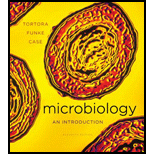
Concept explainers
To write:
The omitted step in a Gram stain method that allow differentiation of Gram-positive and Gram-negative cells.
Given:
“Gram stain” “differentiation “and “omitted step”
Introduction:
In 1884, the Danish scientist Hans Christian Joachim Gramis discovered the
The main principle of Gram stain is used to differentiate based on the color retaining ability of the stain. Gram-positive bacteria retains crystal violet and appears violet or purple in color under the microscope. Since, the cell wall of Gram-positive bacteria contain thicker peptidoglycan layer. So, it retains the stain during ethanol decolonization step. Whereas in the Gram-negative with thinner peptidoglycan layer denatured during ethanol step and retains the secondary stain (safranin) and appears pink color under the microscopic examination.
Trending nowThis is a popular solution!

Chapter 3 Solutions
Microbiology: An Introduction
- Examine the image below. The bacteria in this image have been treated with gram straining procedure. Indicate the following information A. Shape ........; Gram stain ( Gram (+), Gram (-) or both ... B. Stained color under microscope..... . C. Is the PG wall think, thin or both ..arrow_forward7. Use the image to answer the following questions: (2) A student collects some of this bacteria to create a slide then performs a Gram stain as shown here: A. How many different types of bacteria are growing on the petri dish? B. How do you know (how can you tell the difference between the types of bacteria)? C. What is the Gram reaction and morphology of these cells? D. Based on the Gram stain, could this colony be used to grow pure culture? How do you know?arrow_forwardmicrobiology lab experiment: Simple and Differential staining, Bacterial Shapes Why do the slides have to be heat-fixed before staining? What would happen if the slides were not heat-fixed and then stained?arrow_forward
- 400x 1000x What is the shape of bacteria under a microscope, what color is there, and is there Gram staining is positive or negative.arrow_forwardGive typing answer with explanation and conclusion 1.During the endospore staining method we use the boiling of water on a tripod technique. Why?arrow_forward1. A student is directed to make a simple stain of coli with crystal violet, but got mixed up and used safranin instead. How would their observations be different? Would the information obtained be any different? 2. How is the procedure different when taking cells from a solid medium compared to taking cells from a liquid medium? Why is it important that your smear be thin?arrow_forward
- 1. Please explain the characteristic differences between Bright Field Microscope and Inverted microscope. 2. Explain the relationship between bacterial cell wall with gram positive and gram positive in the staining process. Please state the chemicals used and their functions.arrow_forward1.why is gram stain considered a differential stain? 2.How do gram positive and gram negative bacteria differ in cellular structure, and how does this contribute to their differential staining properties? 3.How does the age of a culture affect the gram stain reaction? What is an optimum culture age for a valid gram reaction? 4.Which step in the gram stain procedure is most prone to error?If done correctly how might that step affect the end result? 5.what is the function of mordant, and which reagent serves this purpose in the gram stain procedure? 6.List the reagents of the gram star technique in order and their general role in the staining process. 7.In what type of cell, gram -positive or gram-negative , would you find lipopolysaccharide in its cell wall?arrow_forwardAnswer this question xi) What is the most important step in the Gram staining procedure? Why?arrow_forward
- Simple Stain What is the difference between simple stain and complex stain? Describe the color of an S. aureus after performing simple stain with Safranin Red. Why? What do you conclude after performing simple stain and observing “Purple cells longer than they are widearrow_forwardIn Figure 5-5,a. Why do A− and B− cells, by themselves, not formcolonies on the plating medium?b. What genetic event do the purple colonies in themiddle plate represent?arrow_forwardQ2) Why do cheek cells stain red with the gram stain? What is the big red circle in the middle of the cheek cell? - Considering that it isn’t possible to identify bacteria from a Gram stain, why might a physician perform a Gram stain on a sample before prescribing an antibiotic? - What cells stain red in a Gram stain? What cells stain purple in a Gram stain?arrow_forward
 Human Anatomy & Physiology (11th Edition)BiologyISBN:9780134580999Author:Elaine N. Marieb, Katja N. HoehnPublisher:PEARSON
Human Anatomy & Physiology (11th Edition)BiologyISBN:9780134580999Author:Elaine N. Marieb, Katja N. HoehnPublisher:PEARSON Biology 2eBiologyISBN:9781947172517Author:Matthew Douglas, Jung Choi, Mary Ann ClarkPublisher:OpenStax
Biology 2eBiologyISBN:9781947172517Author:Matthew Douglas, Jung Choi, Mary Ann ClarkPublisher:OpenStax Anatomy & PhysiologyBiologyISBN:9781259398629Author:McKinley, Michael P., O'loughlin, Valerie Dean, Bidle, Theresa StouterPublisher:Mcgraw Hill Education,
Anatomy & PhysiologyBiologyISBN:9781259398629Author:McKinley, Michael P., O'loughlin, Valerie Dean, Bidle, Theresa StouterPublisher:Mcgraw Hill Education, Molecular Biology of the Cell (Sixth Edition)BiologyISBN:9780815344322Author:Bruce Alberts, Alexander D. Johnson, Julian Lewis, David Morgan, Martin Raff, Keith Roberts, Peter WalterPublisher:W. W. Norton & Company
Molecular Biology of the Cell (Sixth Edition)BiologyISBN:9780815344322Author:Bruce Alberts, Alexander D. Johnson, Julian Lewis, David Morgan, Martin Raff, Keith Roberts, Peter WalterPublisher:W. W. Norton & Company Laboratory Manual For Human Anatomy & PhysiologyBiologyISBN:9781260159363Author:Martin, Terry R., Prentice-craver, CynthiaPublisher:McGraw-Hill Publishing Co.
Laboratory Manual For Human Anatomy & PhysiologyBiologyISBN:9781260159363Author:Martin, Terry R., Prentice-craver, CynthiaPublisher:McGraw-Hill Publishing Co. Inquiry Into Life (16th Edition)BiologyISBN:9781260231700Author:Sylvia S. Mader, Michael WindelspechtPublisher:McGraw Hill Education
Inquiry Into Life (16th Edition)BiologyISBN:9781260231700Author:Sylvia S. Mader, Michael WindelspechtPublisher:McGraw Hill Education





